Chesebrough-Pond’s
On 30th June, 1955, the Chesebrough Manufacturing Company, Consolidated and the Pond’s Extract Company merged to form Chesebrough-Pond’s, Inc.
See also: Pond’s Extract Company and Chesebrough Manufacturing Company
At the time of the merger, Vaseline and Pond’s branded products were sold in 125 countries and manufactured locally in 35 of them so one of the first acts of the new company was to set up an International Division. The company also began rationalising the production capabilities of the two merged firms and started planning for additional facilities where this was deemed necessary.
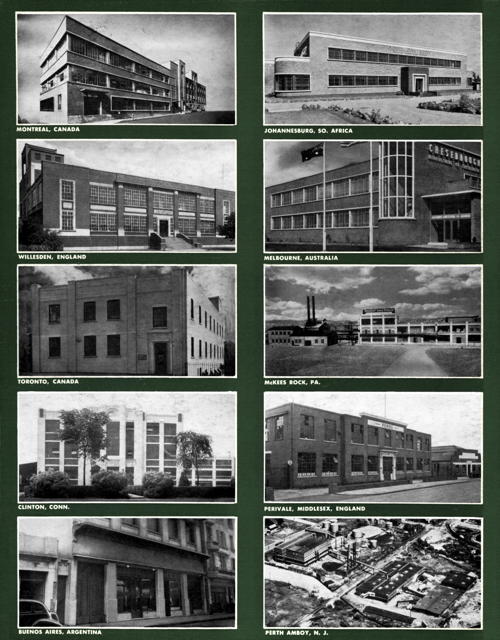
Above: 1955 Some of the combined factory space of the Pond’s and Chesebrough throughout the world.
In 1956, the New York offices of Chesebrough and Pond’s were largely consolidated at 485 Lexington Avenue and the following year the company’s sales force was also reorganised. Chesebrough products had been sold and distributed by Colgate-Palmolive since 1873 but on June 30, 1957 this contract was terminated and the sales team used by Pond’s was expanded to meet the needs of the entire company.
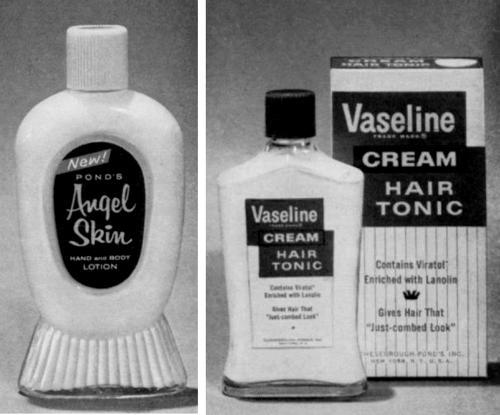
Above: 1957 Angel Skin Hand Lotion and Vaseline Hair Tonic in new packaging. These were the first two products to have their packaging updated after the merger.
Diversification
The board at Chesebrough-Pond’s decided to reduced the company’s dependence on cosmetics and toiletries by diversifying its product range through acquisitions, starting in 1956 with the purchase of Seeck & Kade, Inc., manufacturers of Pertussin Cough Syrup. Chesebrough-Pond’s would go on to acquire interests in a wide range of products including: swabs and cotton balls – Q-Tips, Inc. (1962); hospital supplies – Lily White Sales Co., Inc. (1966), Faichney Instrument, Inc. (1966) and Ballo Thermometer Co. (1966); convenience foods – Ragú Packing Co. (1969) and Adolph’s Ltd. (1974); pharmaceuticals – Day-Baldwin, Inc. (1969); children’s clothing – Health-Tex, Inc. (1973); footwear – G. H. Bass & Co. (1978); and tennis racquets – Prince Manufacturing, Inc. (1982). Many of these companies supplied limited regional markets when they were purchased and Chesebrough-Pond’s increased their sales and profits by making them national brands. However, not all acquisitions worked out as expected and some were resold; Day-Baldwin, for example, was disposed of in 1973.
Cosmetic acquisitions
Chesebrough-Pond’s also extended its cosmetics and toiletry lines through acquisitions. It entered into negotiations for the purchase of Hazel Bishop but wisely withdrew, then went on to procure the cosmetic and toiletry interests of the Vick Chemical Company in September, 1958. The purchase added Prince Matchabelli fragrances, Polyderm creams, Seaforth and Black Watch men’s toiletries and Sofskin hand cream. This enabled Chesebrough-Pond’s to seriously engage in three new categories: fragrances, men’s toiletries and prestige cosmetics. As the company already produced hand creams, within a few months of its purchase it disposed of Sofskin to a new company headed by Alfred Roberts.
See also: Prince Matchabelli and Alfred D. McKelvy (Seaforth)
Although Prince Matchabelli products were manufactured at Chesebrough-Pond’s main Clinton, Connecticut factory, Prince Matchabelli was operated as a separate subsidiary. It marketed Prince Matchabelli perfumes, colognes, dusting powders and soaps, Abano bath oil and cologne, Polyderm creams, and the Black Watch prestige line of men’s toiletries. Aziza eye products were added to the Matchabelli subsidiary after Chesebrough-Pond’s bought the Aziza Eye Cosmetics Division of Mauvel Ltd. in 1959, as were products from the Erno Laszlo Institute and Royall Lyme when these companies were acquired in 1966 and 1967 respectively.
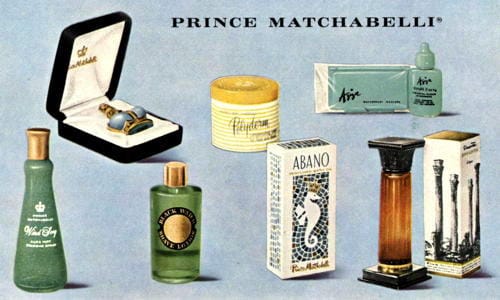
Above: 1959 Products marketed by the Prince Matchabelli subsidiary: Wind Song Aqua Mist Cologne Spray, Prince Matchabelli perfume, Black Watch Shave Lotion, Polyderm Compensating Cream, Abano Bath Oil, Aziza Waterproof Mascara and Simonetta Incanto Cologne.
The Seaforth budget line of men’s toiletries was separated from the other Vick acquisitions and marketed by Chesebrough-Pond’s with their men’s hair products until it was sold to Mary Chess in 1962.
In 1960, Chesebrough-Pond’s bought Northam Warren, the owner of Cutex, Odo-ro-no, Peggy Sage and L’Onglex, adding nail polish, lipsticks and deodorants ranges to its inventory.
See also: Northam Warren
Like Prince Matchabelli, Northam Warren was operated as a separate subsidiary with Northam Warren Jr. remaining on after the purchase to ensure continuity. He was made a vice-president of Chesebrough-Pond’s, until he retired from the position in 1963 but stay on as a company director of Chesebrough-Pond’s until 1970.
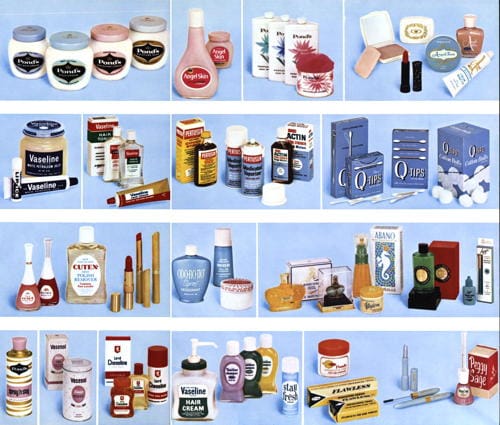
Above: 1963 Some of Chesebrough-Pond’s product range, much of it gained through acquisition.
Along with the Erno Laszlo Institute prestige line of cosmetics and the Royall Lyme line of men’s toiletries, the other major cosmetic acquisition made by Chesebrough-Pond’s in the 1960s was the Consortium Mediterranee de Parfumerie S.A., the makers of Louis Philippe cosmetics, acquired in 1968. I will not be discussing the development of any of these lines here but rather concentrate on three ranges developed by Chesebrough and Pond’s before the merger: Pond’s cosmetics, Angel Face make-up and Vaseline.
Pond’s
The addition of Pond’s Angel Touch in 1957 meant that the Pond’s range now included: Pond’s Cold Cream, Pond’s Vanishing Cream, Pond’s Liquefying Cream, Pond’s Dry Skin Cream, Pond’s Angel Face (Compact Make-up), Pond’s Angel Skin Lotion, Pond’s Angel Skin Hand Cream, Pond’s Angel Touch (liquid make-up), Pond’s ‘Lips’ (lipstick), Pond’s Face Powder, Pond’s Dreamflower Talcum Powder, Pond’s Dreamflower Dusting Powder, Pond’s ‘Cheeks’ (rouge), Pond’s Make-up Pat, and Pond’s Tissues.
Also see the company booklet: Pond’s Beauty Book
In 1959, Chesebrough-Pond’s added Pond’s Moisture Base and modernised the packaging of all the Pond’s creams
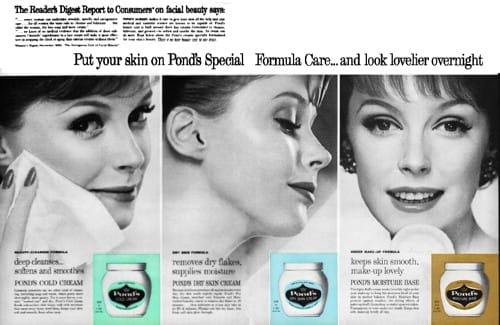
Above: 1961 Pond’s Cold Cream, Pond’s Dry skin Cream and Pond’s Moisture Base in packaging introduced in 1959.
Pond’s creams and lotions were a budget line and to help domestic sales the company introduced Pond’s Beauty Care booths in selected supermarkets in the United States in 1960.
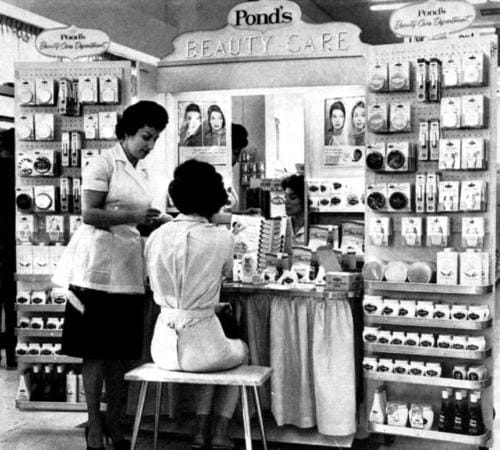
Above: 1960 Pond’s Beauty Care booth. Small items such as compacts, foundation, face powder and lipsticks were hung in newly developed ‘pilfer-proof’ packs.
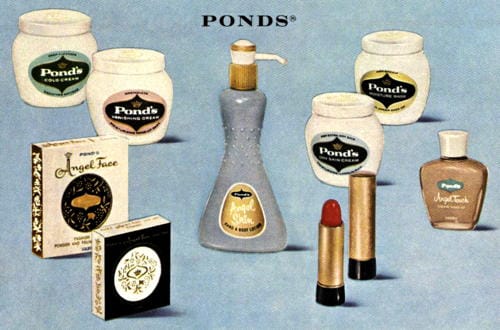
Above: 1959 Pond’s products in new packaging. Each of the four Pond’s creams now has a differently coloured label to make shelf selection easier – Cold Cream (Aqua), Vanishing Cream (Pink), Dry Skin Cream (Blue) and Moisture Base (Yellow). Matching coloured lids were added in 1963.
Pond’s Skin Fresh skin tonic was added to the Pond’s line in 1960 and subsequently included in the Pond’s beauty routine.
1. Select appropriate cream for your skin. Tie back hair and apply cream over you face and neck. (If using Vanishing Cream, limit time of facial to one minute.)
2. Stoke the cream up your neck to the chin, using alternate sweeps of the palms of both hands. With the back of your hands, gently pat the skin under the jaw-line.
3. Bring hands together, small fingers touching, at the center of your chin. Sweep back to the earlobes. Lift hands away from the face before making the next stroke.
4. Press the full length of your index fingers against the sides of your nose and draw them gently back across your cheekbones and up in a curve to your temples.
5. Bring fingertips together at bridge of nose. Sweep them back in an arc across the forehead. Smooth away “frown area” between eyebrows with middle fingertips.
6. With the pads or your middle fingers, tap cream around the eyes, from the outside corners in toward the bridge of your nose, circling up and around eyelids.
7. Remove excess cream with tissues, following the same upward, outward path of your facial. Replace tissues often to present a clean surface next to your skin.
8. Soak a cotton square with Pond’s Skin Fresh and pat it gently over your freshly creamed face and neck. This removes all traces of cream, cools and tones the skin.(Chesebrough-Pond’s, 1961, pp. 8-9)
This gave way to a much simpler idea, the Pond’s 7-Day Beauty Plan which recommended using Pond’s twice each night, once to remove make-up and then a second time to clean out hidden dirt and moisturise. This promotional idea was first used in England in 1961, before being taken up by other Chesebrough-Pond’s subsidiaries and then the parent company in the United States in 1963.
During the 1960s, numerous skin creams and cleansers from competitors appeared on the market placing increasing pressure on the Pond’s lines, particularly Pond’s Cold Cream. Some relief was supplied by the growing use of eye make-up in the 1960s when the company advertised the use of Pond’s Cold Cream to remove eye make-up in the ‘Here’s Pond’s in your eye’ television campaign begun in 1967. However, by the late 1960s it was clear that Pond’s skin creams needed updating.
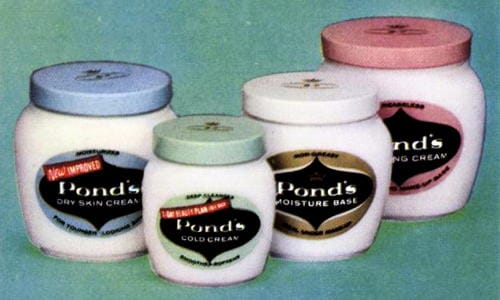
Above: 1964 Pond’s Dry skin Cream, Pond’s Cold Cream, Pond’s Moisture Base and Pond’s Vanishing Cream now with matching coloured lids.
In 1969, a new skin-care line-up was assembled. Pond’s Dry Skin Cream was retained due to consistent sales, as was Pond’s Cold Cream. Pond’s Vanishing Cream and Pond’s Moisture Cream were removed and replaced by Pond’s Light Moisturizer which, like its predecessors, was positioned as a greaseless foundation. A second new product, Oily Skin Treatment, which was not a cream, was also added to the line filling an obvious gap – teenager and problem skins. Unlike Fresh Start (1964), Pond’s medicated cleansing gel for acne, this was aimed at skins with minor blemishes.
Pond’s Oily Skin Treatment: “In one little jar, a super blotting cream that cleanses and treats oily skin.”
Pond’s Dry Skin Cream: “A homogenized emollient cream that does the good replenishing things the expensive creams do.”
Pond’s Light Moisturizer: “A sheer, greaseless protector and prettier to wear under make-up.”
Pond’s Cold Cream Cleanser: “Specially compounded ceresine sweeps away beauty-dimming dirt instantly.”
Together the four Pond’s products were marketed in the Pond’s ‘Skin Basics’ campaign, the key being that a customer had to purchase two lines in the range no matter what type of skin they had.
Normal. To create a healthy moisture balance and prevent your skin from drying out prematurely. Cleanse your face with Pond’s Cold Cream every night. Rub in a little Pond’s Light Moisturizer before bed and before breakfast. Light Moisturizer disappears into your skin to keep it soft and dewy. The Pond’s Normal Skin Basics will put roses in your cheeks.
Dry. To smooth out little lines, deep moisturize and stop flaking. Pat on and tissue off Pond’s Cold Cream to deep cleanse. Then massage in the rich emollients in Pond’s Dry Skin Cream for overnight beauty treatment, under makeup protection. The Pond’s Dry skin Basics. For a skin that’s petal soft.
Oily. To free your pores of blemish-causing oil and cut down on shine. First remove stubborn eye makeup with gentle Pond’s Cold Cream. Cleanse the rest of your face with Pond’s Oily Skin Treatment and rinse with warm water. Then smooth in more Oily Skin Treatment overnight and under makeup. The Pond’s Oily Skin Basics. Your skin will look fresh as a daisy.(Pond’s advertisement, 1970)
New Pond’s skin-care cosmetics were added during the 1970s including Pond’s Lemon Cold Cream (1971), Pond’s Lemon Creamy Cleanser (1971), Pond’s Peach-Scented Cold Cream (1972), and Pond’s Cream & Cocoa Butter Hand Lotion (1978) but none of these have survived as first developed. The two biggest sellers, Pond’s Cold Cream, first introduced in 1904, and Pond’s Dry Skin Cream, which debuted in 1941, are still on the market today.
Angel Face
Pond’s Angel Face Compact Make-up first appeared in 1946. It sold well all through the 1950s as a ‘powder and foundation in one’. By 1958, it was available in eight shades (Natural, Ivory, Pink, Tawny, Bronze, Blushing, Golden and Tan).

Above: 1958 Make-up Shades.
In 1959, the product was reformulated with ‘cosmetic-silicones’ and now came in nine ‘fashion co-ordinated colours’ which were much the same as before (Natural Angel, Ivory Angel, Pink Angel, Tawny Angel, Bronze Angel, Blushing Angel, Golden Angel, Tan Angel and Deep Tan Angel). Previously, Angel Face shades had been based on skin tones but now they were also matched with clothing, the idea being that Angel Face would enable skin tones to be changed to coordinate with any fashion colour.
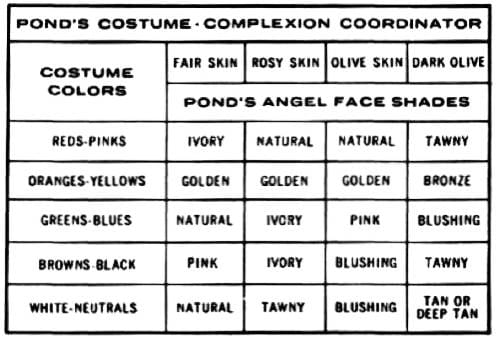
Above: 1960 Fashion co-ordinated colours for Angel Face Compact Make-up.
Paris was still the fashion capital of the world, a status reinforced in 1947 by the introduction of Dior’s ‘New Look’, so the company introduced the new Angel Face fashion shades with promotions in 1959 and 1960 with prizes of free trips to Paris.
Angel Touch Liquid Make-up – a liquid foundation that could be dispensed one drop at a time from a squeeze bottle – had been introduced in 1957 in six ‘Love-light’ shades (Natural, Blushing, Tawny, Ivory, Golden, and Tan) along with Angel Touch Powders (Shades: Natural, Peach, Rose Brunette, Pink Rachel, Rachel, Brunette, Golden Rachel and Deep Tan). By 1960, the Angel Touch shade range had been increased to nine to match those offered in Angel Face Compact Powders with a no-colour ‘Luminous Angel’ Angel Touch face powder added to the range in 1961.
In 1962, Chesebrough-Pond’s combined all of its Pond’s make-up lines – foundations, powders, lipsticks and rouge – under the Angel Face trademark which meant the end for Angel Touch. This made a lot of sense as women were using both Angel Face and Angel Touch interchangeably, for example, starting out with Angel Touch Liquid Make-up in the morning and then touching up with Angel Face Compressed Powder during the day.
Additional Angel Face products were added to the line in 1962 including: Angel Face Medicated Compact and Angel Face Medicated Cream Make-up, both aimed at the youth and skin problem market; Angel Face Galaxy Lipsticks; and a new compact, the Angel Face Date Case. All of these additions and changes were possibly prompted by the arrival of Noxzema’s Cover Girl medicated make-up range in 1961. Aimed at the same youth market as Angel Face, Cover Girl would go on to become one of the best selling make-up lines in the United States.
See also: Cover Girl
As the move towards the ‘Natural Look’ accelerated in the 1960s the Angel Face line also added a number of brush-on powders including: Angel Face Brush-Alive (1965) to be applied over foundation; Angel Face Blush ’n Glo (1969), a blusher; Angel Face Brush and Gloss (1971), a blusher for both cheeks and lips; and Brush-On Blush (1971). Then, in 1972, it released Angel Face Color Cups, a finger-applied face colour for eyes, cheeks and lips.
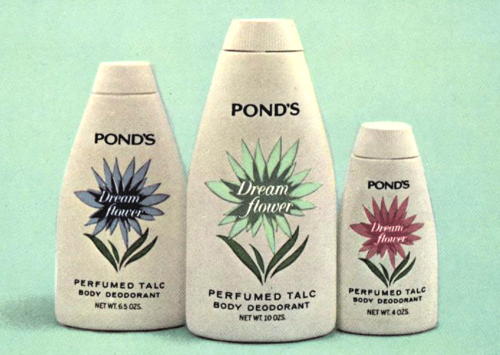
Above: 1968 Dreamflower Perfumed Talc in new plastic containers.
Vaseline
Vaseline Petroleum Jelly in various forms remained a good seller for Chesebrough-Pond’s throughout the entire life of the company and its sales continued to grow until the 1980s. The same could not be said of the Vaseline Hair Care lines. Valcreem, a hair cream in a tube, was added to the range in 1957 and sales of all Vaseline hair products went well until the late 1960s when there was a general decline in the use of all brilliantines by men as the dry look took hold.
Trying to adapt to the times, Chesebrough-Pond’s added the non-greasy Groom & Clean, a water-active cleansing hair groom to its men’s hair lines (1963) and then Groom & Clean Hairspray for men (1971) but neither products were leaders in their field.
Chesebrough-Pond’s did much better with the introduction of Vaseline Intensive Care Lotion (1969). By 1972 it was the market leader in its category, beating Jergens which up until then had been number one. The success of the original product quickly spawned a number of additions including: Vaseline Intensive Care Bath Beads and Bath Oil (1971); Heavy-Duty Vaseline Intensive Care (1972); Vaseline Intensive Care Baby (1972), a line consisting of powder, lotion and oil; Vaseline Intensive Care Wipe ’n Dipe (1972), a pre-diapering tissue; Vaseline Intensive Care Mineral Bath (1975); Vaseline Intensive Care Herbal (1975); Vaseline Intensive Body Splash (1975); and Vaseline Intensive Herbal Body Splash (1975). Despite increasing competition, Vaseline Intensive Care managed to capture over 25% of the hand and body lotion market in the United States and has remained popular worldwide ever since.
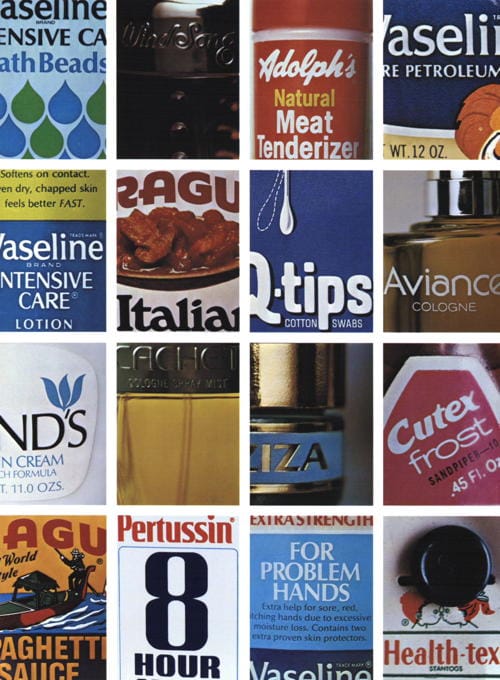
Above: 1976 Some Chesebrough-Pond’s products. By the 1970s cosmetics, toiletries and fragrances made up less than 25% of Chesebrough-Pond’s sales.
Unilever
In the 1980s the performance of a number of Chesebrough-Pond’s interests begin to falter and in 1984 its earnings declined for the first time in 29 years (Chesebrough-Pond’s USA, Inc., 1984, p. 106). Then in 1985 it bought the Stauffer Chemical Company for US$1.25 billion which put the company deep in debt. With debt and depressed earnings Chesebrough-Pond’s became a takeover target and in December 1986 the board agreed to being acquired by Unilever N.V. for US$3.1 billion.
Timeline
| 1955 | Pond’s Extract Company and Chesebrough Manufacturing Company, Consolidated merge. International Division of Chesebrough-Pond’s established. |
| 1956 | Seeck & Kade, Inc. acquired. Clinton, Connecticut plant refitted. New York offices merged. Chesebrough-Pond’s (Japan) Ltd. established. |
| 1957 | Distribution agreement with Colgate-Palmolive-Peet terminated. Sales force of Chesebrough-Pond’s expanded. New packaging for Vaseline hair tonics and Pond’s Angel Skin hand lotion. New Products: Valcreen, hair cream in a tube; Pond’s Angel Touch liquid make-up; and Pond’s Clean & Sweet (UK). |
| 1958 | Prince Matchabelli, Seaforth and Sofskin acquired from Vick Chemical Company; Sofskin sold soon after. Domestic Marketing Division set up in the United States. Manufacturing to starts in Italy. Vaseline Petroleum Jelly repackaged. |
| 1959 | Aziza Eye Cosmetics Division of Mauvel Ltd. acquired. Pond’s range repackaged. New Products: Pond’s Moisture Base; and Pond’s Flowing Cold Cream. |
| 1960 | Northam Warren acquired. U.S. Brush Company, Omaha purchased. New Products: Pond’s Skin Fresh. |
| 1961 | Domestic marketing divided into three divisions: Cosmetic Division (Pond’s, Cutex, Odo-ro-no), Proprietaries and Specialties Division (Vaseline, Pertussin and Actin), Prince Matchabelli Division (Matchabelli and Aziza). Angel Face cosmetics introduced into the UK. |
| 1962 | Q-Tips, Inc. acquired. Vasenol Werke (West Germany) bought. New Italian subsidiary established. Seaforth sold to Mary Chess. All Pond’s make-up products to be marketed under the Angel Face trademark. New Products: Angel Face Medicated Compact Powder; Angel Face Medicated Cream Make-up; and Angel Face Galaxy lipsticks. |
| 1964 | Angel Face medicated products repackaged. Pond’s 7-Day Beauty Plan first introduced in England. New Products: Fresh Start medicated cleansing gel; and Angel Face Brush-Alive. |
| 1965 | New Products: Groom & Clean Hair Groom. |
| 1966 | Lily White Sales Co. Inc., Faichney Instrument Corporation and Ballo Thermometer Company acquired and put into newly established Hospital Products Division. Erno Laszlo Institute bought and added to Prince Matchabelli division. |
| 1967 | Royall Lyme Ltd. makers of men’s toiletries bought and added to Prince Matchabelli division. New Products: Angel Face matt make-up ‘Nothing On’. |
| 1968 | Acquired Societe Francaise de Distribution, S.A. (SFD) and Consortium Mediterranee de Parfumerie S.A. (CMP). Dreamflower Talc repackaged in plastic containers. New Products: Angel Face Gold-Lightly. |
| 1969 | Ragu Packing Co., Inc. and Day-Baldwin Inc. acquired. Majority interest in International Chemical & Cosmetic Co S.p.A. (Milan) established. Health and Beauty Products Division established to sell moderately priced cosmetics, toiletries, proprietary and specialty products to U.S. chain stores, food chains (largest sales), drug chains and discount stores. New Products: Vaseline Intensive Care Lotion; Pond’s Light Moisturizer; Pond’s Oily Skin Treatment; and Angel Face Blush ’n Glo. |
| 1970 | Angel Face Medicated make-up repackaged. |
| 1971 | Vaseline Petroleum Jelly repackaged in new oval shaped jars. New Products: Vaseline Intensive Care Bath Beads; and Vaseline Intensive Care Bath Oil; Pond’s Lemon Cold Cream; Pond’s Lemon Creamy Cleanser; Angel Face Brush and Gloss; Angel Face Brush-On Blush; and Groom & Clean Hairspray. |
| 1972 | New Products: Vaseline Intensive Care Cream; Vaseline Intensive Care Baby line; Vaseline Intensive Care Wipe ’n Dipe wipes; Pond’s Peach-Scented Cold Cream; and Angel Face Color Cups. |
| 1973 | Health-Tex, Inc. and Adolph’s Ltd. acquired. Day-Baldwin subsidiary sold. |
| 1975 | New Products: Vaseline Intensive Care Mineral Bath. |
| 1978 | G. H. Bass & Co. acquired. New Products: Pond’s Cream & Cocoa Butter hand lotion; and Rave home permanent. |
| 1985 | Prince Manufacturing, Inc. acquired. |
| 1985 | Stauffer Chemical Company bought. |
| 1986 | Chesebrough-Pond’s acquired by Unilever N.V. |
First Posted: 17th November 2015
Last Update: 18th February 2024
Sources
Chesebrough-Pond’s, Inc. Annual Reports 1955-1978.
Chesebrough-Pond’s USA, Inc. (1994). International Directory of Company Histories Vol. 8. Boston, MA: St. James Press.
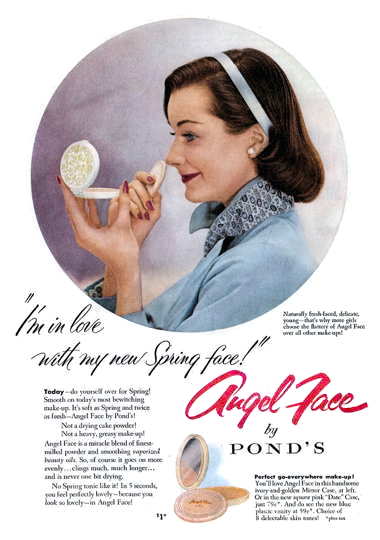
1956 Pond’s Angel Face compact powder.
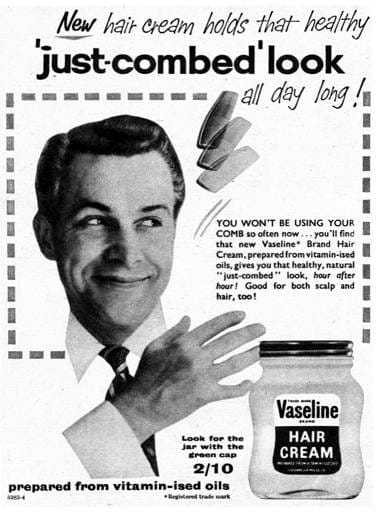
1956 Vaseline Hair Cream as sold in Great Britain.
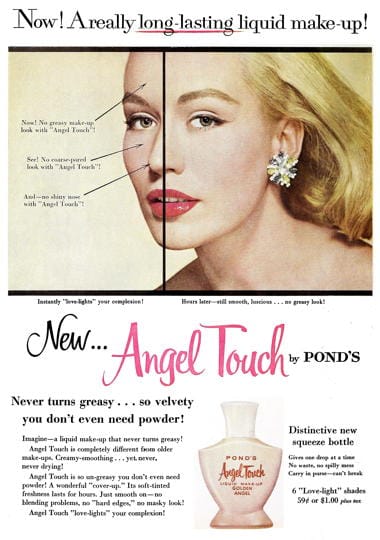
1958 Pond’s Angel Touch Liquid Make-up.
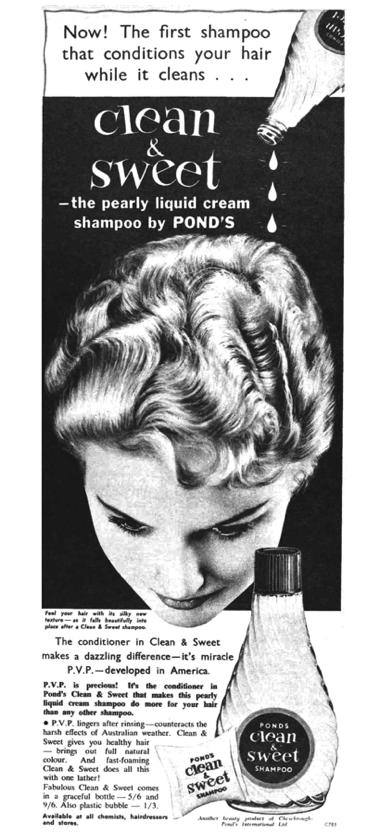
1958 Pond’s Clean & Sweet shampoo as sold in Australia. This was one of a number of products that was not released in the American market. Other overseas lines included: Pond’s Cold Cream Soap, Tissues and Spray ’N Stay hair spray; Vaseline shampoos and bath oils; Peggy Sage, Glazo and L’Onglex nail polishes and lipsticks; Lord Cheshire men’s toiletries; and Louis Philippe cosmetics.
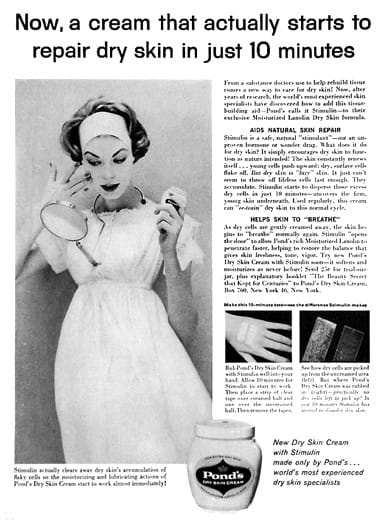
1959 Pond’s Dry Skin Cream with ‘Stimulin’.
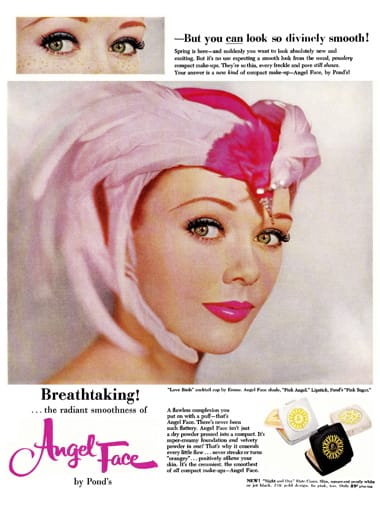
1959 Pond’s Angel Face Compact Powder.

1959 Pond’s Cold Cream.
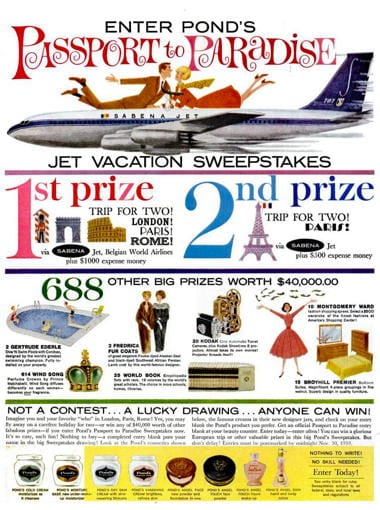
1959 Pond’s ‘Passport to Paradise’. Chesebrough-Pond’s introduced their new look Pond’s creams with a ‘Passport to Paradise’ promotion in which contestants could win a trip to Paris.
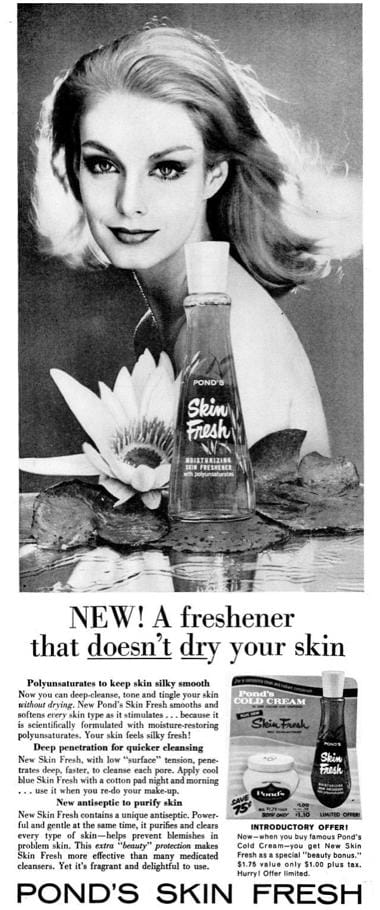
1960 Pond’s Skin Fresh containing polyunsaturates and an antiseptic.

1960 Pond’s Angel Touch Liquid Make-up and Powder.
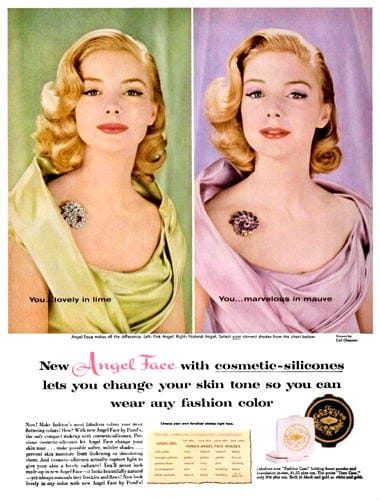
1960 Pond’s Angel Face Compact Powder with ‘cosmetic-silicones’ which changed skin tones so that they matched clothing colours.
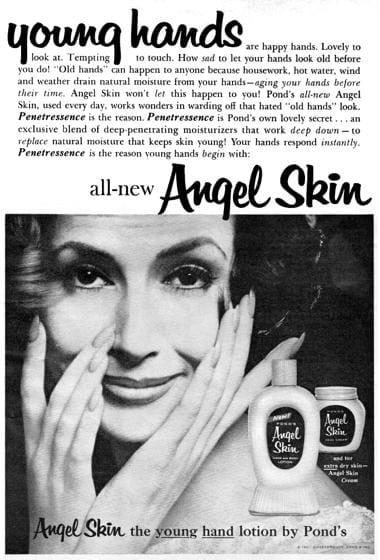
1961 Pond’s Angel Skin hand lotion and cream.
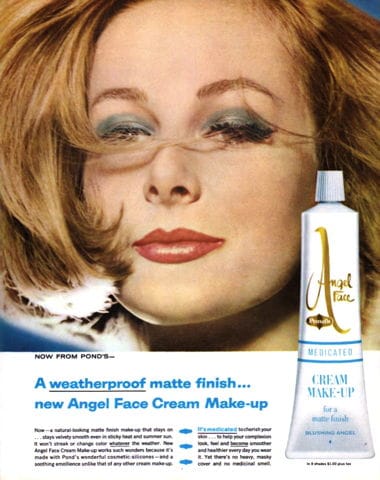
1962 Angel Face Medicated Cream Make-up. Along with Angel Face Medicated Compact Powder these medicated cosmetics were probably introduced due to the success of similar products by Noxzema’s Cover Girl line, first introduced in 1961.
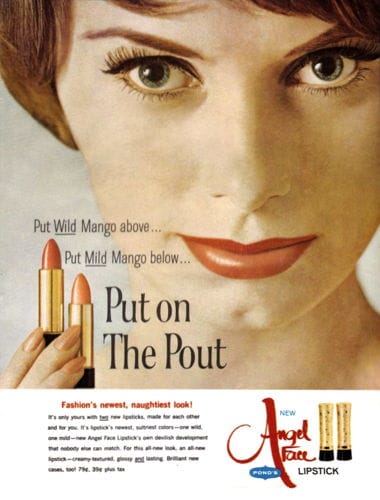
1962 Angel Face Lipstick.

1962 Vasenol products made by Vasenol Werke Dr. Arthur Köpp KG, Oberndorf/Neckar, manufacturers of toiletries, foot-care and baby products sold in Germany under the trademark Vasenol. It was acquired by Chesebrough-Pond’s in 1962.
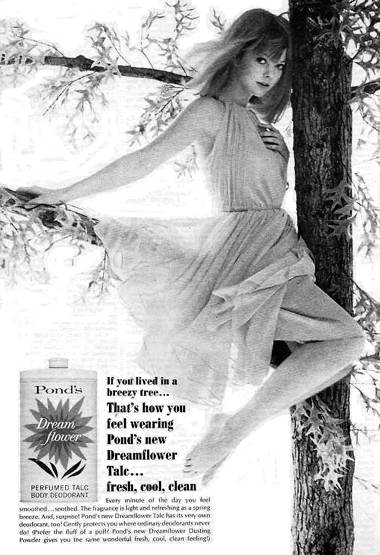
1965 Pond’s Dreamflower Talcum Powder. The line came in a range of packages in different parts of the world but in the United States it was sold in tins until these were replaced with plastic containers in 1968.
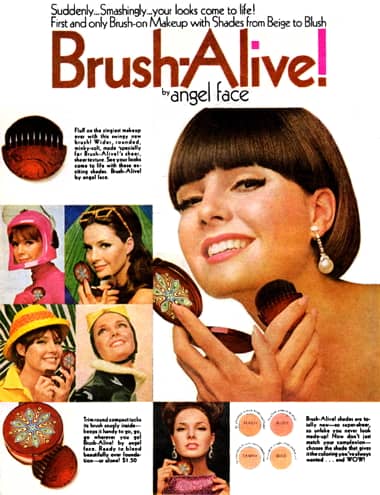
1965 Pond’s Angel Face Brush-Alive compact and brush. Shades: Peach, Blush, Tawny and Beige.
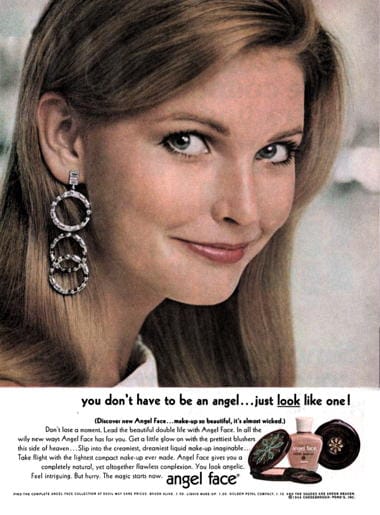
1966 Pond’s Angel Face.
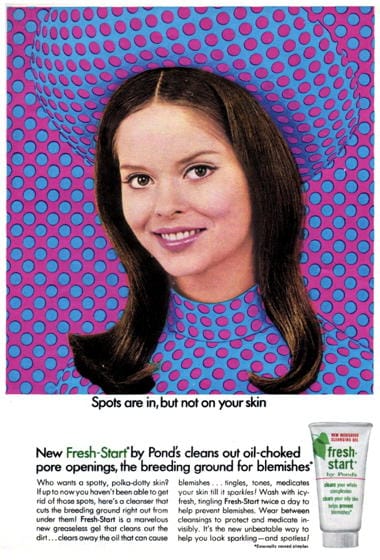
1966 Pond’s Fresh Start, a medicated cleansing gel for acne introduced in 1964.
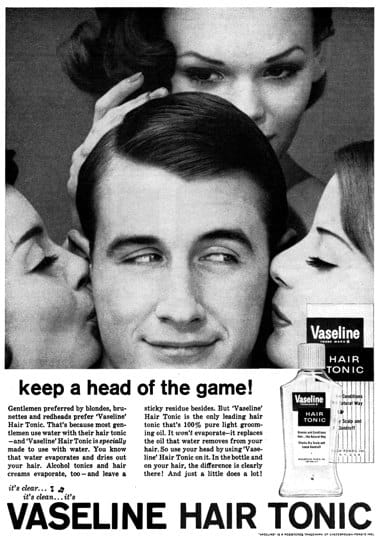
1966 Vaseline Hair Tonic. Sales dropped when the use of brilliantines declined in the late 1960s and men let their hair grow long.
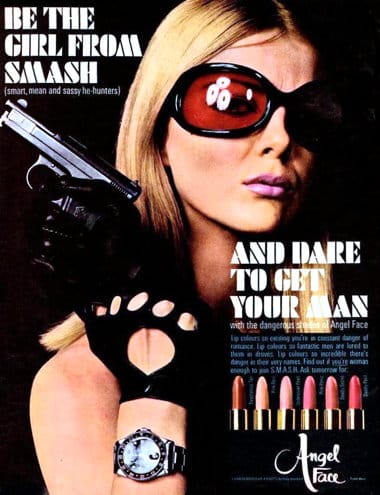
1967 Pond’s Angel Face lipsticks.
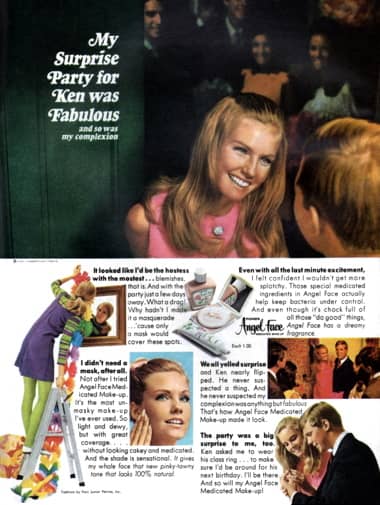
1967 Pond’s Angel Face Medicated Make-up.

1967 Pond’s Fresh-Start medicated cleansing gel for acne. This 10-day treatment used a similar promotional idea to the earlier very successful 7-day beauty plan.
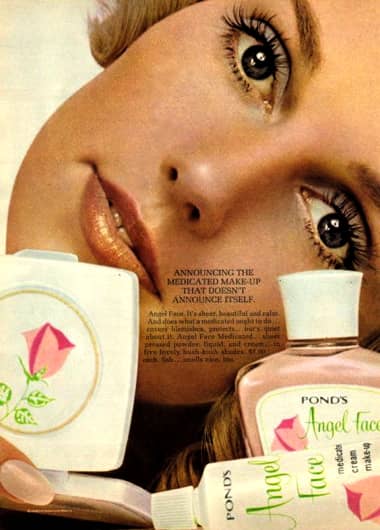
1968 Pond’s Angel Face medicated make-up in compact, lotion and cream.
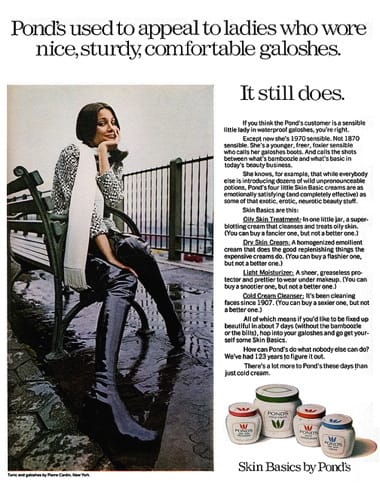
1970 Pond’s Skin Basics. Customers needed to buy at least two products to use a Skin Basics routine.
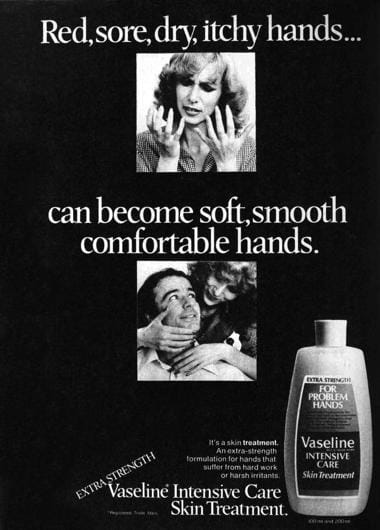
1977 Vaseline Intensive Care. Possibly the most important new skin-care line developed by Chesebrough-Pond’s.
